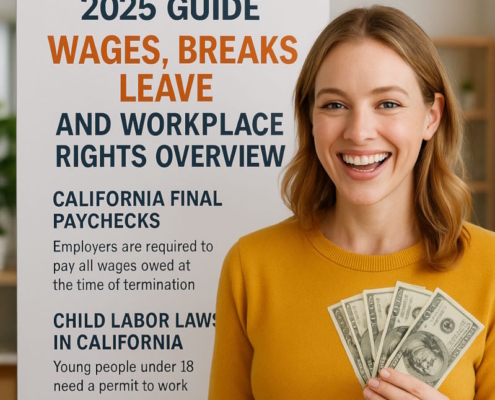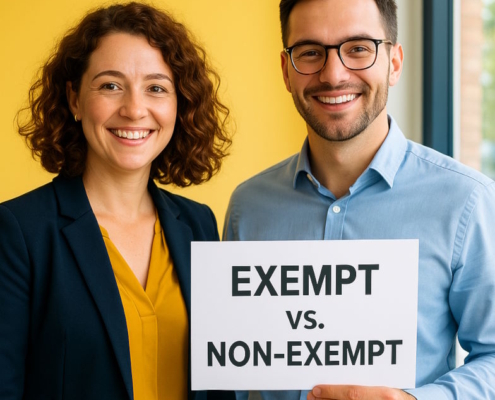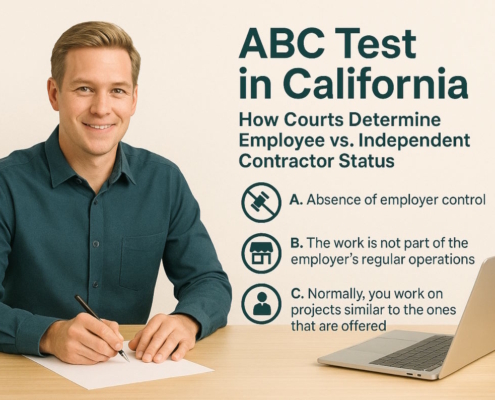What is California law for PTO?
California law declares vacation time to be earned wages, and vacation time is accumulated as work is performed. So, an employee who has the right to ten days of vacation per year will after six months of work earn five days of vacation time. Vacation leave cannot be taken away, even when the employee quits or is fired. However, an employer is allowed to place a cap on vacation days. This means that once an employee earns a certain amount of vacation, they must use it in order to earn any more. When employment is terminated, all unused vacation time must be paid out to the employee in his or her final paycheck.
Can you use PTO immediately?
Under the DLSE’s enforcement policy, an employer is allowed to provide a specific period of time at the start of employment during which a new employee does not earn any vacation leave. This could be applicable during an introductory period (i.e., 90 days), or could last for as long the first year of work.
However, a waiting period such as the one described is only acceptable if the reasons behind the waiting period are valid and not phony. For instance, the following vacation accrual plan would not count as valid:
- Year 1: no vacation earned
- Year 2: two weeks of vacation earned
- Year 3: one week of vacation earned
In the example above, it is clear that the two weeks of vacation earned in the second year actually include one week earned during the first “probationary” year. For employees who experience this scenario and are terminated in the first year, or during the “phony” waiting period, they are entitled to prorated vacation pay. That said, if the waiting period provision is in fact valid, then an employee who is terminated during this time is not eligible for any vacation pay.
Example: Patricia starts a new job at a seafood restaurant in Manhattan Beach. When she asks about the company’s vacation policy, her boss tells her that during the first year of employment, she will not earn any vacation time. Patricia learns from a coworker that during the second year of employment, she may expect to earn two weeks of time off. However, in the third year, this drops down to one week. When Patricia decides she doesn’t like her new job and quits after six months, she wonders if she is entitled to any pay out related to her waiting period and vacation time. Because her company had a phony waiting period, Patricia is indeed entitled to prorated vacation pay.
How does PTO work for vacation?
Under California law, paid vacation is a form of wages, as it is earned by performed labor. Depending on an employer’s vacation plan, an employee might earn vacation leave on a day-by-day or weekly basis, or otherwise based on pay period. For example, an employee who works eight hours per day, 40 hours per week as a full-time worker might be entitled to two weeks of annual vacation time (10 working days). This works out to 1.5 hours of vacation earned per week.
Let’s break down this calculation:
- 10 vacation days a year 8 hours/day = 80 hours of vacation time per year
- 80 hours of vacation time per year 52 weeks per year = 1.538 hours of vacation earned each week
It is a bit more complicated to calculate the vacation pay owed to terminated employees. When employees quit or are fired and have unused vacation time, they are paid the value of their earned vacation time. However, this pay must be prorated on a daily basis and must be paid at the final rate of pay at the time of termination. For example, let’s consider an employee who earns two weeks annual vacation (10 working days) and quits on the 109th day of the calendar year. This employee is paid $20 an hour and has not used any vacation days that year. He or she is owed $480 at the time of termination.
Let’s look at how their vacation pay out is calculated:
- 109 days 365 days/year = 30%
- 30% of 80 hours vacation = 24 hours of vacation earned through that 109th day of the year
- 24 hours of unused vacation $20/hour = $480 vacation pay due at end of employment
Example: Jessalyn works as a salesperson at Adidas, where she earns $18 per hour. Jess recently got a new job at Louboutin, and she is planning to terminate her employment at Adidas tomorrow, July 9. At Adidas, Jess has been entitled to take ten vacation days every year. So far, this year she has taken three days off to visit her family. Jess is aware that when she quits, she should be paid for her unused vacation days. She wants to know what this amount will be, because she would like to show up to her new job wearing a pair of Louboutins. Let’s help Jess out:
- July 9 is the 190th day of the calendar year. So, Jess will have worked 190 days this year at the time of her quitting. She is entitled to 80 hours of vacation time but has already used three days (24 hours) of it. Therefore, as of now, she has 56 hours remaining.
- 190 days 365 days/year = 52%
- 52% of 56 hours vacation = 29 hours vacation banked through the 190th day of the year, July 9
- 29 hours $18/hour = $522 vacation pay due at end of employment.
When Jess quits her job at Adidas, she should receive $522 for unused vacation time. This would buy her a single Louboutin shoe. She will have to save up for the other.
Can you have different PTO policies for different employees?
It is legal for an employer to have a vacation policy that only gives certain employees vacation, so long as there is no illegal discrimination involved. Under California law, an employer may offer vacation leave to full-time employees, but not part-time employees. The employer is also allowed to not give vacation time to temporary, casual, or probationary workers.
Example: Quinn has just started a part-time job at Netflix, where he will work twenty hours a week. After half a year, he wants to take a trip with his girlfriend to Mexico. When he asks his boss how much vacation time he is entitled to, his boss informs him that because Quinn is a part-time employee, he does not get any vacation leave. His boss agrees to consider Quinn for full-time employment after six months, at which time Quinn would be able to start earning vacation time as a full-time employee.
Use-It-Or-Lose-It Policies in California
A use-it-or-lose-it policy means that an employee who does not use their earned vacation time by a certain time (usually the end of the calendar year) will lose the unused balance. Under California law, this type of policy is illegal. In California, vacation pay is considered earned wages, and therefore an employee is entitled to the monetary value of the days off. A policy that allows for unused vacation pay to be “lost” is thus not legal.
Example: Violet works at a beauty store and is entitled to take ten vacation days per year. As of December, Violet has not used any of her vacation time, hoping to use it in January. She and her friends are planning a ski trip to Colorado. However, on December 31, her vacation leave disappears – all ten days of it. Upset, Violet asks her employer what happened to it. Her boss explains that the company has a “use-it-or-lose-it” policy, and because Violet did not use her vacation before the end of the year, she has given it up. Angry, Violet contacts a lawyer, who tells her that under California law, her employer’s vacation policy is illegal because vacation time counts as wages earned. Violet sues her employer for denying her wages.
California PTO Cap
A vacation or PTO policy that puts a cap on PTO is legal under California law. This means that once an employee earns a certain number of PTO days, they must use some before more can be earned. In California, PTO cap must, of course, be reasonable.
DLSE has encountered vacation policies that force all vacation to be taken in the year that it is earned. These policies have been deemed to be unfair and unenforceable.
Example A: Clay works at Nordstrom where he is entitled to ten days of vacation every year. Clay would like to save up his vacation days over the next year and a half so that he can take an extended trip to Europe. However, his boss tells Clay that he must take his ten vacation days by the end of the calendar year. There is no rollover. Clay finds an attorney, because this vacation policy is unfair.
Example B: Victoria works at a think tank, where she earns ten days of vacation every year. She would like to bank her vacation time over the next two years so that she can take a twenty-day tour of Italy. Unfortunately, her employer places a cap on vacation leave. Once an employee earns the equivalent of fifteen days off, he or she must use some of this time before earning more. Thus, Victoria reduces her planned vacation to fifteen days.
Do managers have to approve PTO?
In California, an employer is allowed to control when an employee takes vacation and how much is used at any one time.
Example: Jonathan works at an Apple store in Santa Monica where he earns ten days of vacation time every year. This year would like to take a Christmas vacation to Utah. Unfortunately, his boss tells him that because the Christmas period is so busy at the store, he needs Jonathan to take his vacation after the holidays. His employer has every right to ask this, and Jonathan must put off his vacation.
Example: Carrie works at the same Apple store as Jonathan. She would like to visit her parents in Vermont on the Fourth of July. She asks for five days off. Her boss tells her that he is short-staffed that week because of all the other employees who have already asked for time off. He understands that Carrie would like to see her family, so he asks if she can take off three days instead of five. He has every right to ask this, and Carrie cuts her vacation down to three days.
PTO Payout in California
Under California law, it is legal for an employer to pay an employee for vacation earned but unused at the end of the year.
Example: Clarissa works at a nail salon. She has not been able to take a vacation this year due to financial constraints. At the end of the year, her boss says that because Clarissa did not take any vacation days, she will be paid their worth. Clarissa would have liked her days to roll over into the next year, but she understands that her boss is allowed to pay her their worth in wages.
Paid Time Off
Some employers have paid time off (PTO) plans or policies. This a program where employees are given a specific number of paid days off that can be used for either sick leave or vacation leave. The DLSE takes the position that just like typical vacation policies, employees under these programs have the right to use their PTO days and cannot have them taken away. As such, under these policies, PTO is earned on a day-to-day or weekly basis, there may be a cap on accrued paid time off, and if an employee does not use days by the time of termination, the employee must be compensated for those days.
Example: Connor works at a surf shop. His employer has instituted a general PTO policy, through which Connor is entitled to fifteen days of paid time off per year. Connor is planning to take a vacation to Alaska in April for ten days. But when Connor comes down with a bad flu in February, he is forced to take five days off work while contagious. Connor must use his PTO for these sick days, leaving him with ten days in the bank. Because Connor also wants to take a day or two off later in the year, he decides to trim his Alaska trip down to five days.
Advanced Vacation
Under California law, an employer is allowed to advance vacation to an employee, letting an employee take vacation before it is actually earned. Because of California’s opinion that vacation counts as earned wages, advanced vacation qualifies as advanced wages. This means that if an employee takes an advance on vacation and then quits or is fired before all the advanced vacation is earned, the employer cannot deduct that time from the final paycheck. It becomes an employer debt.
Example: Cody works at a barbershop. For years he has dreamed of taking a two-week vacation to Moldova so that he can try crushing grapes at harvesttime. As of August, he only has half of the vacation time he needs to take his trip. He asks his boss if he can be advanced another week of vacation time. His boss agrees, and Cody takes his trip. Shortly after Cody returns, Cody’s boss fires him for screaming at a dissatisfied customer. Cody’s employer, however, cannot deduct the advanced week of vacation from Cody’s final paycheck.
Do you get paid for PTO when you quit California?
The employer is required to to make a PTO vacation payout when an employee quits. Does California require PTO payout upon termination? California does require PTO payout upon termination. If an employer does not compensate an employee for unused vacation time at the time of termination, the employee may file a wage claim with the Division of Labor Standards Enforcement (DLSE). It is also possible for the employee to file a lawsuit against his or her employer and try to recover the lost wages in court.
The Procedure
A claim filed with a local office of the Division of Labor Standards Enforcement is first assigned to a Deputy Labor Commissioner. The commissioner may decide how to proceed; whether the claim will be referred to a conference or hearing, or outright dismissed.
If the claim is referred to a conference, then both parties will be summoned to meet to see if the claim can be resolved. If the claim is not resolved, it will either be dismissed for a lack of evidence or referred to a hearing.
At the hearing, parties testify under oath and are recorded. Afterward, an Order, Decision, or Award (ODA) will be served.
Either party can appeal the ODA to a civil court for trial.
ODA
If an ODA is granted in favor of an employee, and the employer fails to pay, the DLSE can have the court enter the ODA as a ruling against the employer.
Retaliation
If an employer in any way retaliates against an employee, the employee may file a discrimination/retaliation complaint with the Labor Commissioner’s Office. It is also possible to file a lawsuit against the employer.































